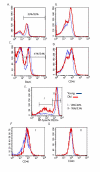Aged B lymphocytes retain their ability to express surface markers but are dysfunctional in their proliferative capability during early activation events
- PMID: 19014641
- PMCID: PMC2615744
- DOI: 10.1186/1742-4933-5-15
Aged B lymphocytes retain their ability to express surface markers but are dysfunctional in their proliferative capability during early activation events
Abstract
Background: Ageing is associated with dysfunction in the humoral response leading to decreased protection against infectious diseases. Defects in T cell function due to age have been well characterized but it is unclear if dysfunctions in antibody responses are due to deficiencies in a helper environment or intrinsic B cell defects. Previous studies from our laboratory have shown that aged B lymphocytes are able to differentiate into high affinity antibody-secreting cells at a frequency similar to their young counterparts. However, expansion of B cells in vivo was reduced in aged animals when compared to young.
Methods: To further investigate the cause of this reduced expansion, we have now examined early activation events of aged B cells in response to anti-CD40 monoclonal antibody (mAb) and lipopolysaccharide (LPS) stimulation in vitro. To do this spleen cells were harvested from young, middle-aged and aged quasi-monoclonal (QM) mice and cultured in complete RPMI for 24 and 48 hours. Cultures contained either LPS or anti-CD40 mAb and murine IL-4. Cells were collected and analyzed using flow cytometry. To examine the proliferative capacity of aged B cells spleen cells were collected as before and cultured in 96 well microtiter plates with either LPS or anti-CD40 mAb and murine IL-4 for 24 hours. Tritiated thymidine ([3H]-Tdr) was added to each well and incubated for another 24 hours after which cells were collected and analyzed using a scintillation counter.
Results: Resting aged B cells exhibited similar levels of CD40 expression when compared to young cells and efficiently up-regulated CD86 and CD69 and also down-regulated CD38 upon stimulation. However, aged B cells proliferated less than young B cells and showed a consistent, but not statistically significant, reduction in their ability to form blast cells.
Conclusion: Aged B cells exhibited a reduced response in some early activation events but produced at least a partial response in all cases. Thus, therapeutic intervention may be possible, despite intrinsically different responses in aged B cells.
Figures






Similar articles
-
Identification of two distinct CD5- B cell subsets from human tonsils with different responses to CD40 monoclonal antibody.Eur J Immunol. 1993 Apr;23(4):873-81. doi: 10.1002/eji.1830230416. Eur J Immunol. 1993. PMID: 7681401
-
A monoclonal antibody against a murine CD38 homologue delivers a signal to B cells for prolongation of survival and protection against apoptosis in vitro: unresponsiveness of X-linked immunodeficient B cells.Immunology. 1995 Jun;85(2):248-55. Immunology. 1995. PMID: 7642213 Free PMC article.
-
IL-4-producing CD8+ T cell clones can provide B cell help.J Immunol. 1995 Apr 1;154(7):3118-27. J Immunol. 1995. PMID: 7897202
-
Anti-CD40 monoclonal antibody induces the proliferation of murine B cells as a B-cell mitogen through a distinct pathway from receptors for antigens or lipopolysaccharide.Immunol Lett. 1995 Mar;45(3):195-203. doi: 10.1016/0165-2478(95)00006-q. Immunol Lett. 1995. PMID: 7558174
-
Comparison of in vitro and in vivo mitogenic and polyclonal antibody and autoantibody responses to peptidoglycan, LPS, protein A, PWM, PHA and Con A in normal and autoimmune mice.J Clin Lab Immunol. 1985 Feb;16(2):93-109. J Clin Lab Immunol. 1985. PMID: 3886911 Review.
Cited by
-
Impaired memory B-cell recall responses in the elderly following recurrent influenza vaccination.PLoS One. 2021 Aug 5;16(8):e0254421. doi: 10.1371/journal.pone.0254421. eCollection 2021. PLoS One. 2021. PMID: 34351920 Free PMC article. Clinical Trial.
-
Memory B cells from older people express normal levels of cyclooxygenase-2 and produce higher levels of IL-6 and IL-10 upon in vitro activation.Cell Immunol. 2010;266(1):90-7. doi: 10.1016/j.cellimm.2010.09.002. Epub 2010 Sep 17. Cell Immunol. 2010. PMID: 20889146 Free PMC article.
-
B cell-intrinsic changes with age do not impact antibody-secreting cell formation but delay B cell participation in the germinal centre reaction.Aging Cell. 2022 Sep;21(9):e13692. doi: 10.1111/acel.13692. Epub 2022 Aug 18. Aging Cell. 2022. PMID: 35980826 Free PMC article.
-
Immunosenescence: signaling pathways, diseases and therapeutic targets.Signal Transduct Target Ther. 2025 Aug 6;10(1):250. doi: 10.1038/s41392-025-02371-z. Signal Transduct Target Ther. 2025. PMID: 40769978 Free PMC article. Review.
-
Spatial dysregulation of T follicular helper cells impairs vaccine responses in aging.Nat Immunol. 2023 Jul;24(7):1124-1137. doi: 10.1038/s41590-023-01519-9. Epub 2023 May 22. Nat Immunol. 2023. PMID: 37217705 Free PMC article.
References
-
- Ghia P, Melchers F, Rolink AG. Age-dependent changes in B lymphocyte development in man and mouse. Exp Gerontol. 2000;35:159–165. - PubMed
-
- Globerson A, Effros RB. Ageing of lymphocytes and lymphocytes in the aged. Immunol Today. 2000;21:515–521. - PubMed
-
- Miller RA. The aging immune system: primer and prospectus. Science. 1996;273:70–74. - PubMed
-
- Blaeser A, Panwar A, Vogel LA. Humoral immunity and aging: intrinsic B cell defects. Current Trends in Immunology. 2007;8:61–67.
Grants and funding
LinkOut - more resources
Full Text Sources
Research Materials

